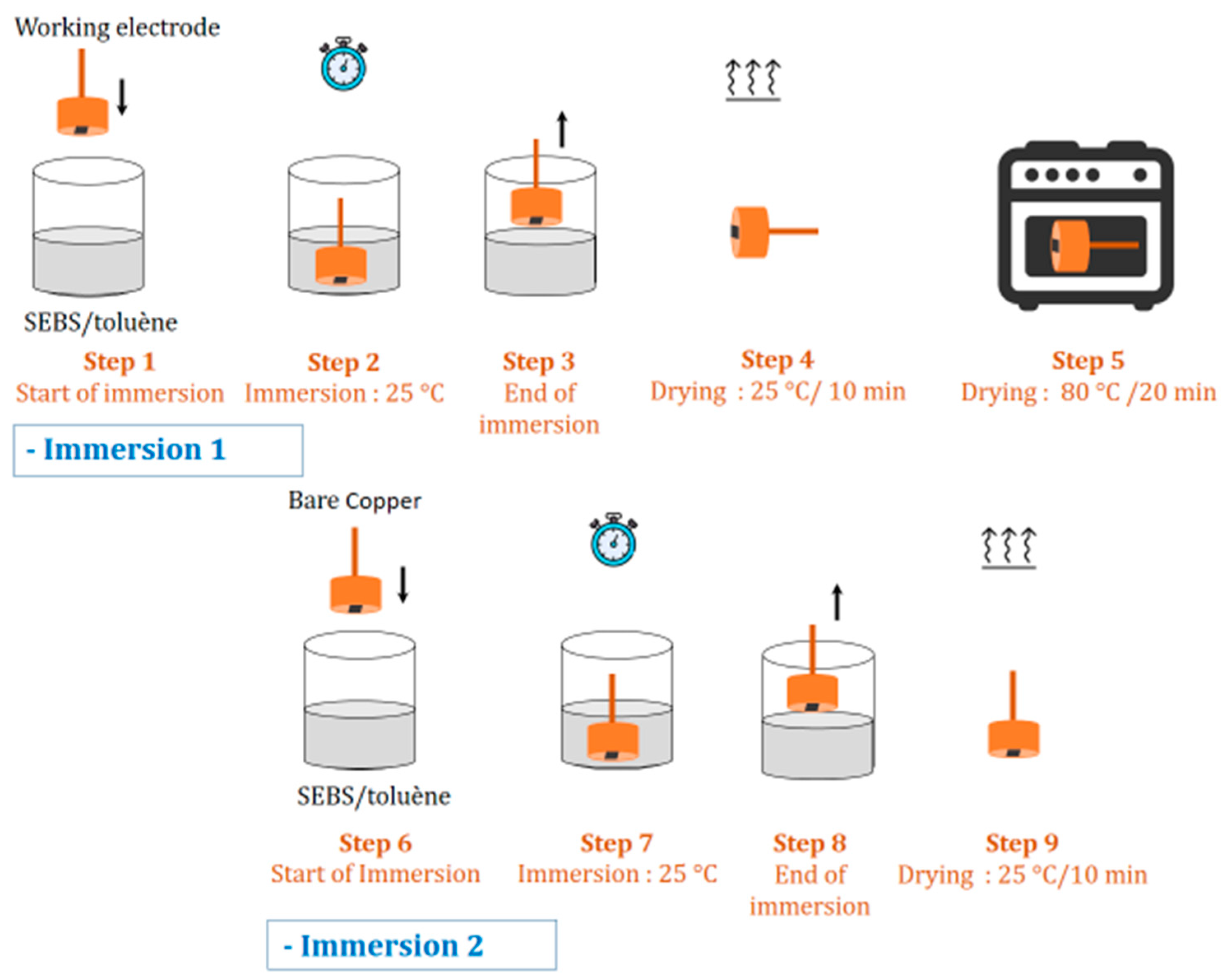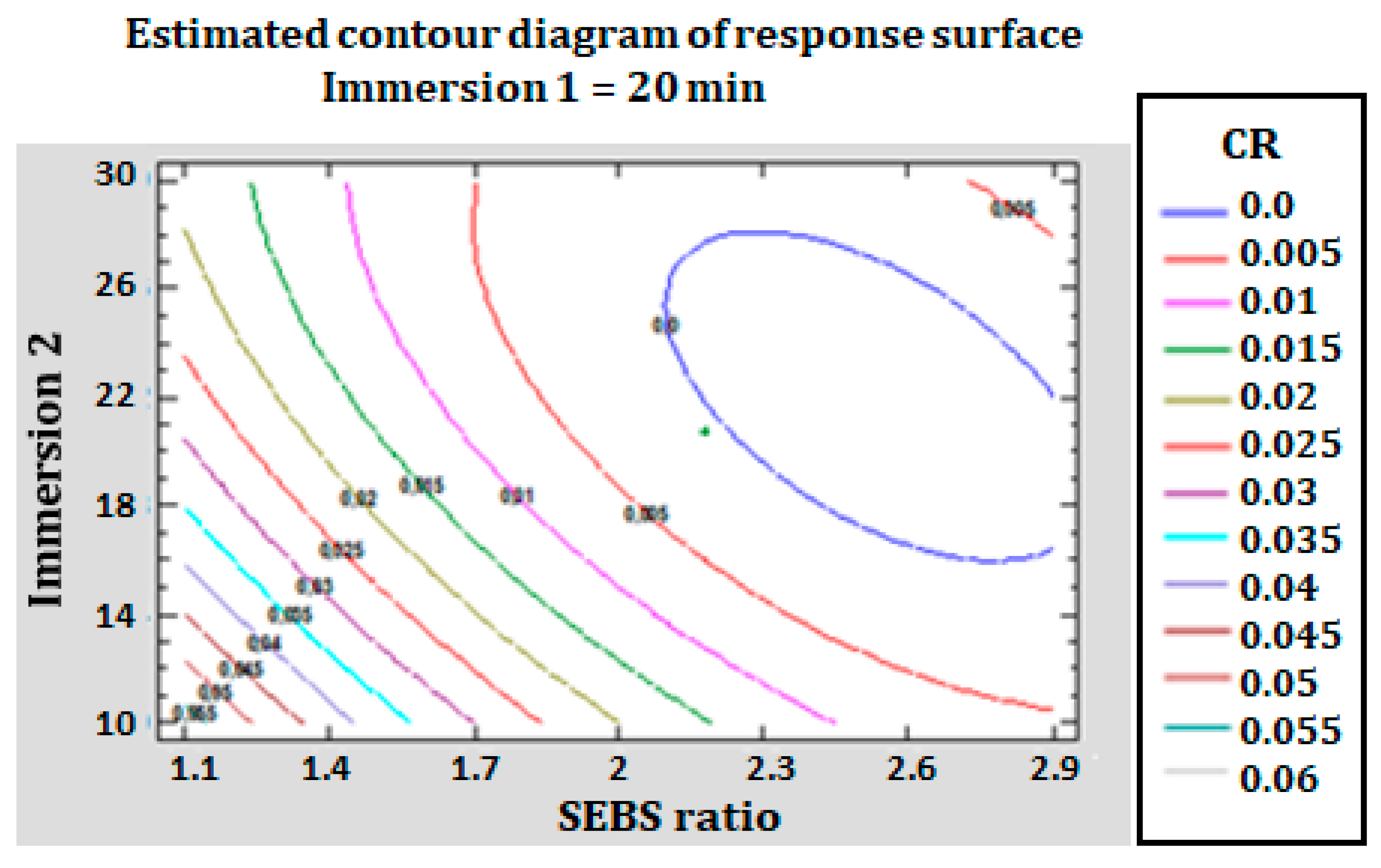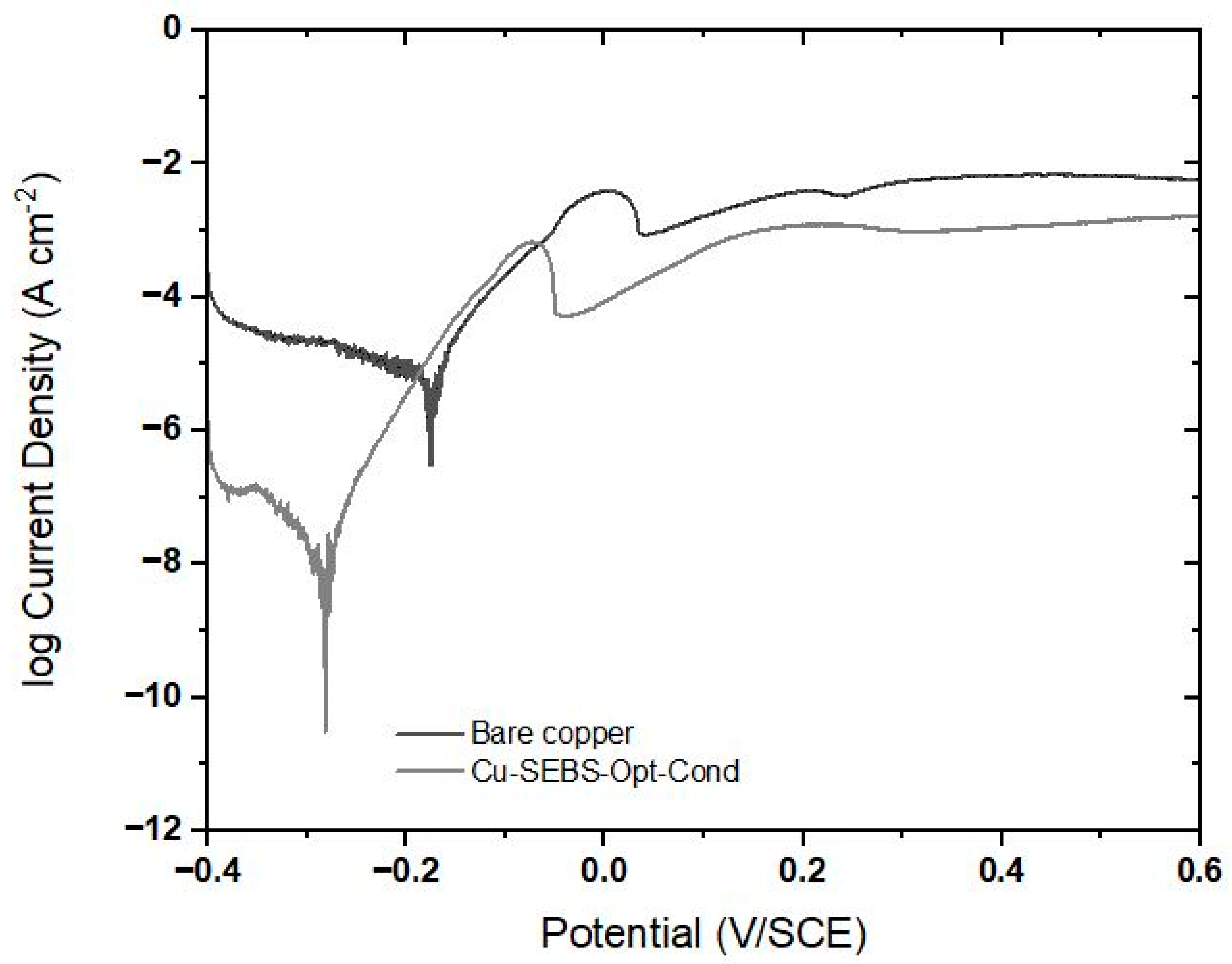Optimizing Experimental Immersion Protocol for SEBS Coating Formation on Copper Surfaces Using Response Surface Methodology
Abstract
:1. Introduction
- (i)
- Highlighting the use of experimental design and RSM to assess the impacts of the basic operating parameters (SEBS ratio, immersion 1, and immersion 2) in the treatment process of the SEBS-coated copper (Cu-SEBS) on the response factor (CR);
- (ii)
- Determining, modeling, and optimizing the operating conditions for producing SEBS coating on the copper with the lowest value of corrosion rate;
- (iii)
- Verifying the model built by experimental design and RSM by employing these optimal operating parameters to explore the corrosion behavior of the SEBS-coated copper at optimal conditions (Cu-SEBS-Opt-Cond) in a 3 wt% NaCl solution.
2. Experimental
2.1. Pre-Treatment of Copper Electrodes
2.2. Preparation of SEBS-Coated Copper Electrodes
2.3. Experimental Design
2.4. Electrochemical Studies
2.4.1. Potentiodynamic Polarization Studies
2.4.2. Voltammetry around OCP (ΔE = ±50 mV)
2.4.3. Electrochemical Impedance Studies
3. Results and Discussion
3.1. Statistical Treatment of Data
3.2. Response Surfaces for Corrosion Rate CR
3.3. Optimal Operating Conditions Experiment
3.4. Confirmation of the Results by Electrochemical Studies
3.4.1. Potentiodynamic Polarization Studies
Potentiodynamic Polarization between −0.4 and +0.6 V vs. SCE
Voltammetry around OCP (ΔE = ±50 mV vs. SCE)
3.4.2. Electrochemical Impedance Spectroscopy (EIS)
4. Conclusions
- The SEBS ratio is the most significant parameter that influenced the CR of SEBS-coated copper.
- The immersion 2, the quadratic effect of the SEBS ratio, the immersion 1 and the interaction SEBS ratio—immersion 2 are important, but they are less significant.
- The fit of the experimental design indicated that the optimum protocol for the SEBS film’s formation on the copper electrode to obtain a lower CR could be found at 2.17% of the SEBS ratio, 20 min of the immersion 1, and 21 min of the immersion 2.
- 0.000174 mm year−1 of the CR, value nearly that of the fitted value (0.0001 mm/year).
- The Rp value equals 58,375 Ω cm2 and is 47-fold higher than that of bare copper.
- The inhibition efficiencies, as derived from both voltammetry conducted around the OCP (η = 99.7%) and EIS (η = 97.89%), are of utmost significance and demonstrate a remarkable level of concurrence.
- The SEBS coating acts as a cathodic-type corrosion inhibitor.
Author Contributions
Funding
Institutional Review Board Statement
Informed Consent Statement
Data Availability Statement
Acknowledgments
Conflicts of Interest
Abbreviation List
| SEBS | Polystyrene-block-poly (ethylene-ran-butylene)-block-polystyrene |
| RSM | Response surface methodology |
| BBD | Box–Behnken Design |
| CR | Corrosion rate |
| OCP | Open circuit potential |
| TPEs | Thermoplastic elastomers |
| Cu-SEBS | SEBS-coated copper |
| DD | Doehlert Design |
| CCD | Central Composite Design |
| Cu-SEBS-Opt-Cond | SEBS-coated copper at optimal conditions |
| k | Number of factors |
| Cp | Replicate number of central points |
| β0 | Constant coefficients of the model |
| βi | Linear coefficients of the model |
| βii | Quadratic coefficients of the model |
| βij | Interaction coefficients of the model |
| Xi, Xj | Coded independent factors |
| ԑ | Error of the model |
| ANOVA | Analysis of variance |
| SCE | Saturated calomel electrode |
| βa | Anodic Tafel coefficient |
| βc | Cathodic Tafel coefficient |
| jcorr | Corrosion current density |
| A | SEBS ratio |
| B | Immersion 1 |
| C | Immersion 2 |
| A2 | Quadratic effect of SEBS ratio |
| C2 | Quadratic effect of immersion 2 |
| AB | Interaction between SEBS and immersion 1 |
| AC | Interaction between SEBS and immersion 2 |
| BC | Interaction between immersion 1 and immersion 2 |
| EIS | Electrochemical impedance spectroscopy |
| Insoluble film of cuprous chloride | |
| Soluble cuprous complex | |
| Ecorr | Corrosion potential |
| η | Protection efficiency |
| Corrosion current density of bare copper | |
| EEC | Electrical equivalent circuits |
| Rs | Solution resistance |
| Rct | Charge transfer resistance |
| Qdl | Capacitance of the double layer |
| Qf | Capacitance of coating |
| Rf | Transfer resistance of the electrons through coating |
| W | Warburg impedance |
| CPE | Constant phase elements |
| nf,ndl | Shift phase associated with Qf and Qdl |
| CPE’s impedance function | |
| Q0 | CPE magnitude |
| j | Imaginary root |
| ω | Angular frequency |
References
- Mansouri, H.; Eghbali, B.; Afrand, M. Producing Multi-Layer Composite of Stainless Steel/Aluminum/Copper by Accumulative Roll Bonding (ARB) Process. J. Manuf. Process. 2019, 46, 298–303. [Google Scholar] [CrossRef]
- Tang, H.; Sun, J.; Pan, J. Electrochemical and Localized Corrosion Behavior of 316 L SS/Copper/316 L SS Sandwich Composite in Chloride-Containing Environment. Corros. Sci. 2022, 209, 110719. [Google Scholar] [CrossRef]
- Yabuki, A.; Tanabe, S.; Fathona, I.W. Self-Healing Polymer Coating with the Microfibers of Superabsorbent Polymers Provides Corrosion Inhibition in Carbon Steel. Surf. Coat. Technol. 2018, 341, 71–77. [Google Scholar] [CrossRef]
- Gul, H.; Algul, H.; Akyol, A.; Uysal, M.; Alp, A. Evaluation of Wear and Corrosion Behavior of Electroless Ni-B-P/CNT Composite Coatings on Aluminum Surfaces. Diam. Relat. Mater. 2023, 137, 110075. [Google Scholar] [CrossRef]
- Qin, J.; Shi, X.; Li, H.; Zhao, R.; Li, G.; Zhang, S.; Ding, L.; Cui, X.; Zhao, Y.; Zhang, R. Performance and Failure Process of Green Recycling Solutions for Preparing High Degradation Resistance Coating on Biomedical Magnesium Alloys. Green Chem. 2022, 24, 8113–8130. [Google Scholar] [CrossRef]
- Masmoudi, F.; Jedidi, I.; Amor, Y.B.; Masmoudi, M. Corrosion Protection Evaluation of Copper Coated with a Block Copolymer and Block Coploymer/Carbon Black Nanoparticles in 3 Wt% NaCl Solution. ChemistrySelect 2023, 8, e202202608. [Google Scholar] [CrossRef]
- Li, X.; Huang, K.; Wang, X.; Li, H.; Shen, W.; Zhou, X.; Xu, J.; Wang, X. Effect of Montmorillonite on Morphology, Rheology, and Properties of a Poly [Styrene–(Ethylene-Co-Butylene)–Styrene]/Poly (ɛ-Caprolactone) Nanocomposite. J. Mater. Sci. 2018, 53, 1191–1203. [Google Scholar] [CrossRef]
- Drobny, J.G. Handbook of Thermoplastic Elastomers; Elsevier: Amsterdam, The Netherlands, 2014. [Google Scholar]
- Zhang, R.; Huang, K.; Zhu, M.; Chen, G.; Tang, Z.; Li, Y.; Yu, H.; Qiu, B.; Li, X. Corrosion Resistance of Stretchable Electrospun SEBS/PANi Micro-Nano Fiber Membrane. Eur. Polym. J. 2020, 123, 109394. [Google Scholar] [CrossRef]
- Grigorescu, R.M.; Ciuprina, F.; Ghioca, P.; Ghiurea, M.; Iancu, L.; Spurcaciu, B.; Panaitescu, D.M. Mechanical and Dielectric Properties of SEBS Modified by Graphite Inclusion and Composite Interface. J. Phys. Chem. Solids 2016, 89, 97–106. [Google Scholar] [CrossRef]
- Mune, M.A.M.; Minka, S.R.; Mbome, I.L. Response Surface Methodology for Optimisation of Protein Concentratepreparation from Cowpea [Vigna unguiculata (L.) Walp]. Food Chem. 2008, 110, 735–741. [Google Scholar] [CrossRef]
- de Lima, T.G.; Rocha, B.; Braga, A.V.C.; do Lago, D.C.B.; Luna, A.S.; Senna, L.F. Response Surface Modeling and Voltammetric Evaluation of Co-Rich Cu–Co Alloy Coatings Obtained from Glycine Baths. Surf. Coat. Technol. 2015, 276, 606–617. [Google Scholar] [CrossRef]
- Senna, L.F.; Luna, A.S. Experimental Design and Response Surface Analysis as Available Tools for Statistical Modeling and Optimization of Electrodeposition Processes. In Electroplating; IntechOpen: London, UK, 2012. [Google Scholar]
- Do Lago, D.C.B.; De Senna, L.F.; Soares, E.C.S.; Da Silva, L.F.; Fernandes, D.S.; Luna, A.S.; D’elia, E. The Use of Experimental Design for the Study of the Corrosion of Bronze Pretreated with AMT in Artificial Rainwater. Prog. Org. Coat. 2013, 76, 1289–1295. [Google Scholar] [CrossRef]
- Chaabani, A.; Aouadi, S.; Souissi, N.; Nóvoa, X.R. Electro-Chemical Impedance Spectral (EIS) Study of Patinated Bronze Corrosion in Sulfate Media: Experimental Design Approach. J. Mater. Sci. Chem. Eng. 2017, 5, 44–54. [Google Scholar] [CrossRef]
- Rios, E.C.; Zimer, A.M.; Mendes, P.C.; Freitas, M.B.; de Castro, E.V.; Mascaro, L.H.; Pereira, E.C. Corrosion of AISI 1020 Steel in Crude Oil Studied by the Electrochemical Noise Measurements. Fuel 2015, 150, 325–333. [Google Scholar] [CrossRef]
- Şenaras, A.E. Parameter Optimization Using the Surface Response Technique in Automated Guided Vehicles. In Sustainable Engineering Products and Manufacturing Technologies; Elsevier: Amsterdam, The Netherlands, 2019; pp. 187–197. [Google Scholar]
- Rahal, C.; Masmoudi, M.; Abdelhedi, R.; Sabot, R.; Jeannin, M.; Bouaziz, M.; Refait, P. Olive Leaf Extract as Natural Corrosion Inhibitor for Pure Copper in 0.5 M NaCl Solution: A Study by Voltammetry around OCP. J. Electroanal. Chem. 2016, 769, 53–61. [Google Scholar] [CrossRef]
- Wang, Y.; You, Z.; Pei, S.; Ma, K.; Dai, C.; Wang, D.; Wang, J.; Pan, F. Corrosion Resistance of a Calcium Carbonate Coating Prepared by Ultrasound-Assisted Chemical Conversion in Calcium Disodium Edetate Solution. J. Magnes. Alloys 2023, in press. [CrossRef]
- del Olmo, R.; López, E.; Matykina, E.; Tiringer, U.; Mol, J.M.C.; Mohedano, M.; Arrabal, R. Hybrid PEO/Sol-Gel Coatings Loaded with Ce for Corrosion Protection of AA2024-T3. Prog. Org. Coat. 2023, 182, 107667. [Google Scholar] [CrossRef]
- Dhouibi, I.; Masmoudi, F.; Bouaziz, M.; Masmoudi, M. A Study of the Anti-Corrosive Effects of Essential Oils of Rosemary and Myrtle for Copper Corrosion in Chloride Media. Arab. J. Chem. 2021, 14, 102961. [Google Scholar] [CrossRef]
- Raza, M.A.; Rehman, Z.U.; Ghauri, F.A. Corrosion Study of Silane-Functionalized Graphene Oxide Coatings on Copper. Thin Solid Film. 2018, 663, 93–99. [Google Scholar] [CrossRef]
- Yu, Y.; Yang, D.; Zhang, D.; Wang, Y.; Gao, L. Anti-Corrosion Film Formed on HAl77-2 Copper Alloy Surface by Aliphatic Polyamine in 3 Wt.% NaCl Solution. Appl. Surf. Sci. 2017, 392, 768–776. [Google Scholar] [CrossRef]
- Sui, W.; Zhao, W.; Zhang, X.; Peng, S.; Zeng, Z.; Xue, Q. Comparative Anti-Corrosion Properties of Alkylthiols SAMs and Mercapto Functional Silica Sol–Gel Coatings on Copper Surface in Sodium Chloride Solution. J. Sol-Gel Sci. Technol. 2016, 80, 567–578. [Google Scholar] [CrossRef]
- Ghelichkhah, Z.; Sharifi-Asl, S.; Farhadi, K.; Banisaied, S.; Ahmadi, S.; Macdonald, D.D. L-Cysteine/Polydopamine Nanoparticle-Coatings for Copper Corrosion Protection. Corros. Sci. 2015, 91, 129–139. [Google Scholar] [CrossRef]










| Factor | Symbols | Levels | ||
|---|---|---|---|---|
| Low (−1) | Center (0) | High (+1) | ||
| SEBS ratio (%) | A | 1.1 | 2 | 2.9 |
| Immersion 1 (min) | B | 10 | 20 | 30 |
| Immersion 2 (min) | C | 10 | 20 | 30 |
| Electrode | Ecorr (mV/SCE) | jcorr μA cm−2 | CR × 10−3 mm year−1 | η (%) |
|---|---|---|---|---|
| Bare Copper | −175 ± 5 | 6.83 ± 0.7 | 79.24 ± 0.2 | − |
| Cu-SEBS-Opt-Cond | −282 ± 5 | 0.015 ± 0.0004 | 0.174 ± 0.02 | 99.7 ± 0.5 |
| Bare Copper | Cu-SEBS-Opt-Cond | |
|---|---|---|
| - | ||
| Rs (Ω cm2) | 7.03 ± 3 | 14.7 ± 2 |
| Rct (Ω cm2) | 1231 ± 200 | 44,457 ± 6000 |
| ) | 121 ± 50 | 2.857 ± 1.2 |
| ndl | 0.711 ± 0.02 | 0.885 ± 0.02 |
| Rf (Ω cm2) | − | 13,918 ± 500 |
| ) | − | 28.61 ± 2.5 |
| nf | − | 0.611 ± 0.01 |
| W (Ω−1 cm−2 s0.5) | 190.8 ± 12 | − |
| η (%) | − | 97.89 ± 1 |
Disclaimer/Publisher’s Note: The statements, opinions and data contained in all publications are solely those of the individual author(s) and contributor(s) and not of MDPI and/or the editor(s). MDPI and/or the editor(s) disclaim responsibility for any injury to people or property resulting from any ideas, methods, instructions or products referred to in the content. |
© 2023 by the authors. Licensee MDPI, Basel, Switzerland. This article is an open access article distributed under the terms and conditions of the Creative Commons Attribution (CC BY) license (https://creativecommons.org/licenses/by/4.0/).
Share and Cite
Masmoudi, F.; Mallah, A.; Masmoudi, M. Optimizing Experimental Immersion Protocol for SEBS Coating Formation on Copper Surfaces Using Response Surface Methodology. Coatings 2023, 13, 1734. https://doi.org/10.3390/coatings13101734
Masmoudi F, Mallah A, Masmoudi M. Optimizing Experimental Immersion Protocol for SEBS Coating Formation on Copper Surfaces Using Response Surface Methodology. Coatings. 2023; 13(10):1734. https://doi.org/10.3390/coatings13101734
Chicago/Turabian StyleMasmoudi, Fatma, Abdulrahman Mallah, and Mohamed Masmoudi. 2023. "Optimizing Experimental Immersion Protocol for SEBS Coating Formation on Copper Surfaces Using Response Surface Methodology" Coatings 13, no. 10: 1734. https://doi.org/10.3390/coatings13101734





